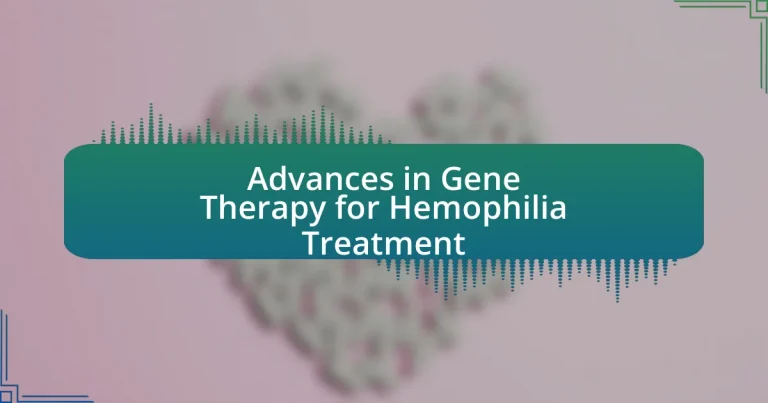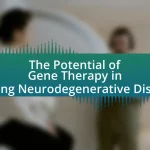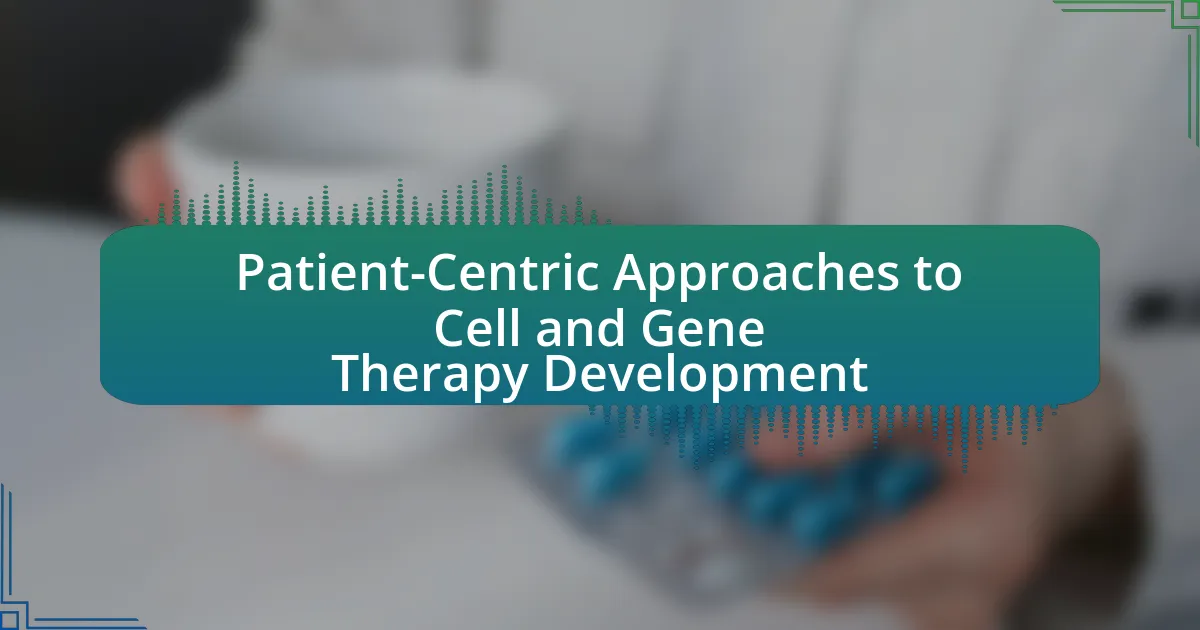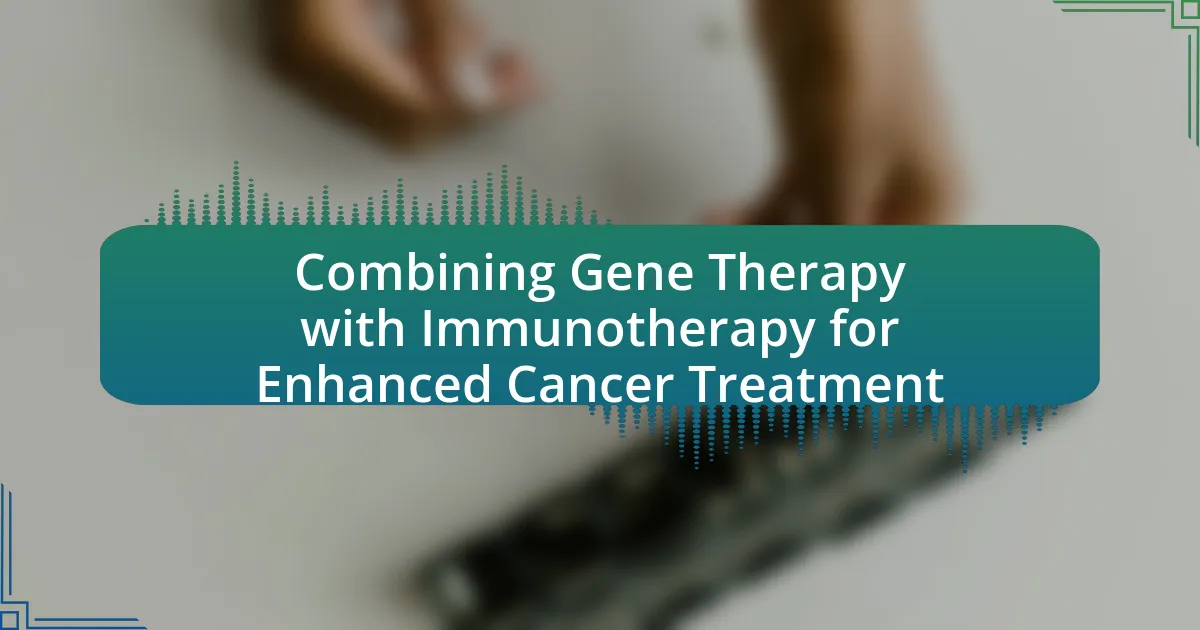The article focuses on recent advances in gene therapy for hemophilia treatment, highlighting the development of adeno-associated virus (AAV) vectors that deliver functional clotting factor genes to the liver. Key clinical trials, such as those involving AAV5-FVIII and Valoctocogene Roxaparvovec, demonstrate sustained increases in Factor VIII levels and significant reductions in bleeding episodes. The evolution of gene therapy techniques, including gene editing and RNA interference, is discussed, along with historical milestones that have shaped the field. The article also addresses potential benefits, challenges, and the regulatory landscape surrounding gene therapy, emphasizing its promising future in providing long-term solutions for hemophilia patients.

What are the recent advances in gene therapy for hemophilia treatment?
Recent advances in gene therapy for hemophilia treatment include the development of adeno-associated virus (AAV) vectors that deliver functional copies of the clotting factor genes directly to the liver. Notably, the clinical trial results for the AAV5-FVIII gene therapy have shown sustained increases in Factor VIII levels in patients with hemophilia A, leading to a significant reduction in bleeding episodes. Additionally, the ongoing studies of AAV-based therapies, such as the one conducted by Pfizer and Sangamo Therapeutics, have demonstrated promising safety profiles and efficacy, with some patients achieving near-normal levels of clotting factors. These advancements indicate a shift towards potentially curative treatments for hemophilia, moving beyond traditional factor replacement therapies.
How has gene therapy evolved in the context of hemophilia?
Gene therapy for hemophilia has evolved significantly, transitioning from early experimental approaches to more advanced and effective treatments. Initially, gene therapy aimed to deliver functional copies of the clotting factor genes, specifically factor VIII and factor IX, to patients with hemophilia A and B, respectively. Recent advancements include the development of adeno-associated virus (AAV) vectors, which have shown promising results in clinical trials by providing sustained expression of the clotting factors. For instance, the clinical trial of the AAV5-hFVIII-SQ gene therapy demonstrated that patients with hemophilia A achieved stable factor VIII levels, reducing bleeding episodes significantly. This evolution reflects a shift towards more personalized and long-lasting therapies, with ongoing research focusing on optimizing vector design and delivery methods to enhance efficacy and safety.
What historical milestones have shaped gene therapy for hemophilia?
The development of gene therapy for hemophilia has been shaped by several key historical milestones. In 1990, the first successful gene therapy trial was conducted, where a patient with adenosine deaminase deficiency received a functional copy of the gene, laying the groundwork for future applications in hemophilia. In 2003, a significant advancement occurred when researchers demonstrated that a single injection of a viral vector could effectively deliver the factor IX gene in a hemophilia B model, resulting in sustained expression of the protein. In 2017, the FDA approved the first gene therapy for hemophilia, called Luxturna, which targeted a different genetic disorder but set a precedent for hemophilia treatments. More recently, in 2020, the FDA approved the gene therapy product Hemgenix for hemophilia B, marking a pivotal moment in the treatment landscape. These milestones collectively illustrate the evolution and progress of gene therapy in addressing hemophilia.
What recent breakthroughs have been made in gene therapy techniques?
Recent breakthroughs in gene therapy techniques include the development of adeno-associated virus (AAV) vectors that enhance the delivery and expression of therapeutic genes in patients with hemophilia. For instance, a study published in the New England Journal of Medicine demonstrated that a single infusion of an AAV-based gene therapy resulted in sustained factor VIII expression in hemophilia A patients, significantly reducing bleeding episodes. This advancement marks a pivotal shift in treatment paradigms, moving from regular infusions of clotting factors to a potential one-time curative approach.
What types of gene therapies are currently being explored for hemophilia?
Currently, several types of gene therapies are being explored for hemophilia, including adeno-associated virus (AAV) vector-based therapies, gene editing techniques like CRISPR/Cas9, and RNA interference approaches. AAV vector-based therapies aim to deliver functional copies of the clotting factor genes directly to the patient’s liver cells, which can produce the necessary proteins to prevent bleeding episodes. For instance, the therapy known as Valoctocogene Roxaparvovec has shown promise in clinical trials by providing sustained expression of factor VIII in hemophilia A patients. Gene editing techniques, such as CRISPR/Cas9, are being investigated to directly correct mutations in the factor genes, potentially offering a one-time curative treatment. Additionally, RNA interference strategies are being studied to modulate the expression of genes involved in the coagulation pathway, thereby enhancing the overall hemostatic response. These approaches represent significant advancements in the treatment of hemophilia, aiming to improve patient outcomes and reduce the need for regular factor replacement therapies.
What are the differences between AAV-based and lentiviral gene therapies?
AAV-based gene therapies utilize adeno-associated viruses to deliver genetic material, while lentiviral gene therapies use lentiviruses for the same purpose. AAVs are known for their ability to transduce non-dividing cells and have a lower risk of insertional mutagenesis, making them safer for certain applications. In contrast, lentiviruses can integrate into the host genome, allowing for stable long-term expression of the therapeutic gene, which is beneficial for conditions requiring sustained gene expression. AAVs typically have a limited packaging capacity of about 4.7 kilobases, while lentiviruses can accommodate larger genetic payloads, up to 8 kilobases or more. These differences influence their respective applications in gene therapy, particularly in treating genetic disorders like hemophilia, where the choice of vector can impact efficacy and safety.
How do these therapies target specific genetic mutations in hemophilia patients?
Gene therapies for hemophilia target specific genetic mutations by utilizing techniques such as gene editing and viral vector delivery to correct or replace defective genes responsible for clotting factor deficiencies. For instance, therapies like adeno-associated virus (AAV) vectors deliver functional copies of the F8 or F9 genes, which encode for factor VIII and factor IX, respectively. These vectors integrate into the patient’s liver cells, enabling the production of the missing clotting factors. Clinical trials have demonstrated that these approaches can significantly increase factor levels in patients with hemophilia A and B, leading to reduced bleeding episodes and improved quality of life.
What are the potential benefits of gene therapy for hemophilia patients?
Gene therapy for hemophilia patients offers the potential benefit of providing a long-term solution by enabling the body to produce sufficient levels of clotting factors, which are deficient in hemophilia. This approach can significantly reduce or eliminate the need for regular infusions of clotting factor concentrates, leading to improved quality of life and decreased healthcare costs. Clinical trials, such as those involving the gene therapy product Valoctocogene Roxaparvovec, have demonstrated that patients can achieve stable and sustained expression of the missing clotting factor, resulting in fewer bleeding episodes and a reduced reliance on factor replacement therapy.
How can gene therapy improve the quality of life for hemophilia patients?
Gene therapy can significantly improve the quality of life for hemophilia patients by providing a long-term solution to the underlying genetic defect that causes the disorder. This innovative treatment aims to introduce functional copies of the gene responsible for producing clotting factors, thereby reducing or eliminating the need for regular infusions of clotting factor concentrates. Clinical trials, such as those conducted by the University of Pennsylvania and reported in the New England Journal of Medicine, have shown that patients receiving gene therapy can achieve stable levels of clotting factors, leading to fewer bleeding episodes and a reduced risk of complications. As a result, hemophilia patients experience greater physical activity, improved mental health, and enhanced overall well-being.
What long-term outcomes can be expected from gene therapy treatments?
Long-term outcomes from gene therapy treatments for hemophilia can include sustained production of clotting factors, reduced bleeding episodes, and improved quality of life. Studies have shown that patients receiving gene therapy can achieve stable levels of factor VIII or factor IX, leading to a significant decrease in the need for regular infusions of clotting factor concentrates. For instance, a clinical trial published in the New England Journal of Medicine demonstrated that patients treated with adeno-associated virus (AAV) vectors maintained therapeutic levels of factor IX for over three years, resulting in a marked reduction in bleeding events. Additionally, long-term follow-up indicates that gene therapy can lead to a durable response, potentially offering a one-time treatment solution rather than lifelong management.
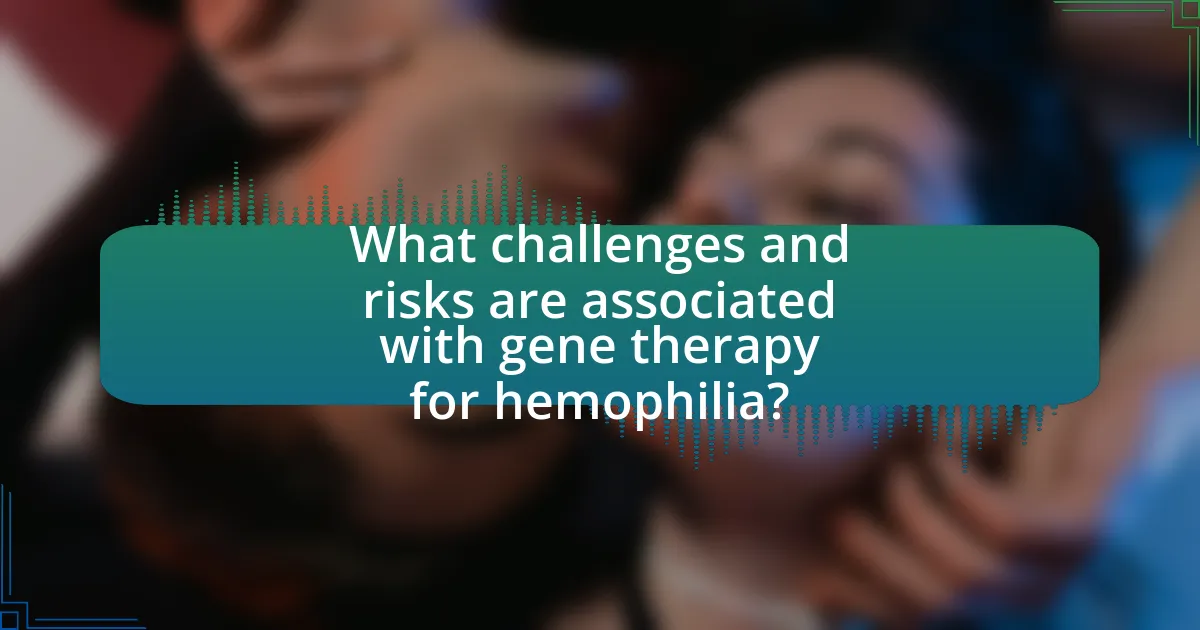
What challenges and risks are associated with gene therapy for hemophilia?
Gene therapy for hemophilia faces several challenges and risks, including immune responses, vector-related complications, and long-term efficacy concerns. Immune responses can lead to the body rejecting the therapeutic vector, which may diminish the treatment’s effectiveness. For instance, the use of adeno-associated viruses (AAVs) as vectors can trigger immune reactions that limit the duration of factor expression. Additionally, there are risks of insertional mutagenesis, where the integration of the therapeutic gene into the host genome could disrupt essential genes, potentially leading to malignancies. Long-term efficacy is also uncertain, as the durability of gene expression may vary, necessitating repeated treatments. These factors highlight the complexities and potential dangers associated with gene therapy for hemophilia.
What are the safety concerns related to gene therapy?
Safety concerns related to gene therapy include the risk of unintended genetic modifications, immune reactions, and potential long-term effects on health. Unintended genetic modifications can occur if the therapy integrates into the wrong part of the genome, potentially leading to harmful mutations or oncogenesis. Immune reactions may arise when the body recognizes the introduced vectors or modified cells as foreign, which can result in inflammation or the destruction of therapeutic cells. Additionally, the long-term effects of gene therapy are still not fully understood, raising concerns about delayed adverse reactions that may manifest years after treatment. These safety issues highlight the need for rigorous clinical trials and monitoring to ensure patient safety in gene therapy applications.
How do immune responses affect the efficacy of gene therapy?
Immune responses significantly impact the efficacy of gene therapy by potentially neutralizing therapeutic vectors and eliciting inflammatory responses. When gene therapy employs viral vectors to deliver genetic material, the immune system may recognize these vectors as foreign, leading to the production of neutralizing antibodies. For instance, studies have shown that pre-existing immunity to adeno-associated virus (AAV) vectors can reduce the effectiveness of gene therapy in hemophilia patients, as these antibodies can prevent the vectors from successfully delivering the therapeutic gene to target cells. Additionally, T-cell responses can lead to the destruction of transduced cells, further diminishing the therapeutic effect. Therefore, understanding and managing immune responses is crucial for enhancing the success of gene therapy in treating conditions like hemophilia.
What are the potential long-term risks of gene therapy interventions?
The potential long-term risks of gene therapy interventions include unintended genetic modifications, immune reactions, and the possibility of tumorigenesis. Unintended genetic modifications can occur if the therapeutic gene integrates into an inappropriate location within the genome, potentially disrupting essential genes or regulatory elements. Immune reactions may arise as the body recognizes the introduced vectors or the therapeutic proteins as foreign, leading to inflammation or reduced efficacy of the treatment. Tumorigenesis is a concern, particularly with viral vectors, as they may activate oncogenes or inactivate tumor suppressor genes, increasing the risk of cancer. These risks underscore the need for thorough long-term monitoring and evaluation in gene therapy applications.
How is the regulatory landscape evolving for gene therapy in hemophilia?
The regulatory landscape for gene therapy in hemophilia is evolving towards more streamlined approval processes and increased collaboration between regulatory agencies and developers. Recent advancements include the U.S. Food and Drug Administration (FDA) and the European Medicines Agency (EMA) implementing expedited pathways for gene therapies, recognizing their potential to provide long-term solutions for patients. For instance, the FDA granted Breakthrough Therapy Designation to several gene therapies targeting hemophilia, which allows for faster clinical development and review. Additionally, the EMA has introduced adaptive pathways that facilitate earlier patient access to innovative treatments while ensuring safety and efficacy are maintained. These changes reflect a growing recognition of the transformative potential of gene therapies in treating hemophilia, as evidenced by the approval of therapies like Zynteglo and Hemgenix, which have demonstrated significant clinical benefits.
What role do regulatory agencies play in the approval of gene therapies?
Regulatory agencies are crucial in the approval of gene therapies, as they ensure the safety, efficacy, and quality of these treatments before they reach patients. Agencies such as the U.S. Food and Drug Administration (FDA) and the European Medicines Agency (EMA) evaluate clinical trial data, manufacturing processes, and post-market surveillance to assess the therapeutic benefits against potential risks. For instance, the FDA’s Breakthrough Therapy designation expedites the development and review of therapies that treat serious conditions, exemplified by the approval of gene therapies for hemophilia, which have undergone rigorous evaluation to confirm their effectiveness and safety profiles.
How do clinical trial processes impact the development of gene therapies?
Clinical trial processes significantly impact the development of gene therapies by providing a structured framework for evaluating safety and efficacy. These processes involve multiple phases, including preclinical studies and clinical trials, which are essential for regulatory approval. For instance, the success of gene therapies for hemophilia, such as the use of adeno-associated virus vectors, has been demonstrated through rigorous clinical trials that assess patient outcomes and potential side effects. The results from these trials inform regulatory bodies like the FDA, which rely on comprehensive data to determine whether a gene therapy can be approved for public use. Thus, the clinical trial process not only validates the therapeutic potential of gene therapies but also ensures that they meet safety standards before reaching patients.
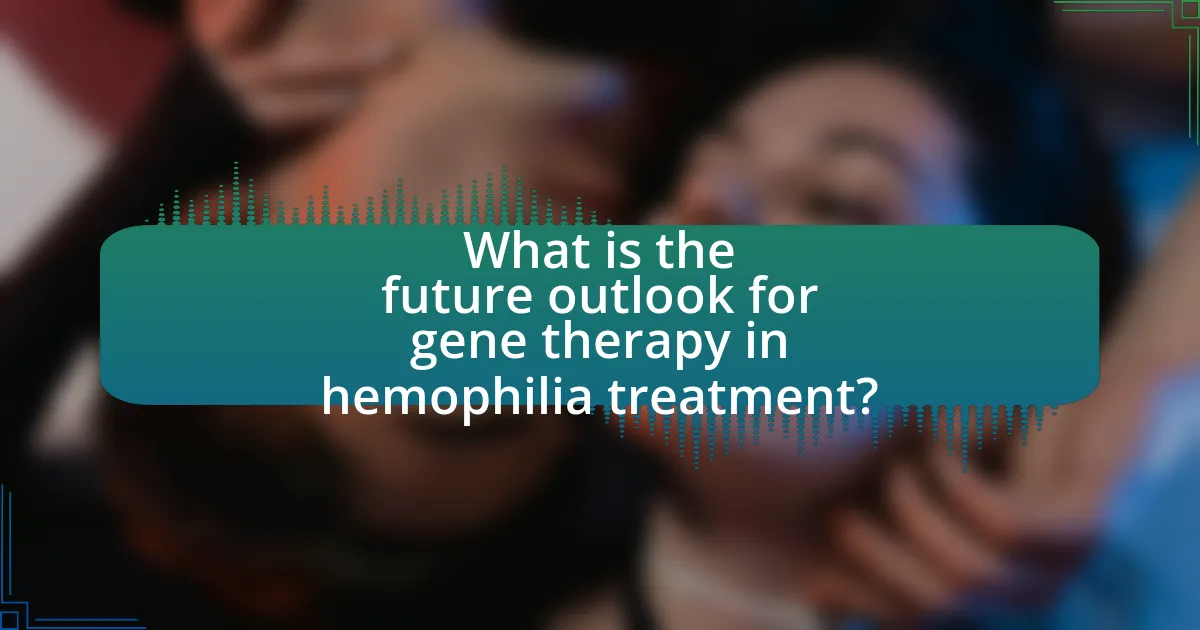
What is the future outlook for gene therapy in hemophilia treatment?
The future outlook for gene therapy in hemophilia treatment is highly promising, with ongoing advancements indicating potential for long-term efficacy and reduced treatment burden. Recent clinical trials, such as those involving AAV-based gene therapies, have shown significant success in achieving stable factor levels in patients, potentially eliminating the need for regular infusions. For instance, the phase 3 trial of etranacogene dezaparvovec demonstrated sustained factor IX expression in hemophilia B patients, with over 90% of participants achieving levels sufficient to prevent bleeding episodes. These developments suggest that gene therapy could transform hemophilia management, offering a one-time treatment solution that addresses the underlying genetic cause of the disorder.
What innovations are on the horizon for gene therapy in hemophilia?
Innovations on the horizon for gene therapy in hemophilia include the development of more efficient delivery systems, such as adeno-associated virus (AAV) vectors, which are being optimized to enhance gene expression and reduce immune responses. Recent studies have shown that next-generation AAV vectors can achieve sustained factor expression with fewer side effects, as evidenced by clinical trials demonstrating long-term efficacy and safety in patients with hemophilia A and B. Additionally, advancements in CRISPR technology are being explored to correct genetic mutations directly, offering the potential for permanent cures. These innovations are supported by ongoing research and clinical trials that aim to improve the precision and effectiveness of gene therapy for hemophilia.
How might advancements in technology enhance gene therapy approaches?
Advancements in technology can enhance gene therapy approaches by improving the precision and efficiency of gene delivery systems. For instance, innovations in CRISPR-Cas9 technology allow for targeted gene editing, which can correct genetic mutations responsible for hemophilia. Studies have shown that CRISPR can achieve high specificity in modifying genes, reducing off-target effects, which is crucial for safe therapeutic applications. Additionally, the development of viral vectors, such as adeno-associated viruses (AAV), has improved the delivery of therapeutic genes to specific tissues, increasing the effectiveness of treatments for hemophilia. Research indicates that AAV vectors can achieve long-term expression of therapeutic genes in liver cells, which is essential for producing clotting factors. These technological advancements collectively contribute to more effective and safer gene therapy strategies for hemophilia treatment.
What role will personalized medicine play in future treatments?
Personalized medicine will play a crucial role in future treatments by tailoring therapies to individual genetic profiles, particularly in conditions like hemophilia. This approach enhances treatment efficacy and minimizes adverse effects by ensuring that patients receive the most suitable interventions based on their unique genetic makeup. For instance, advancements in gene therapy have shown promise in correcting specific genetic mutations responsible for hemophilia, leading to more effective and lasting treatment outcomes. Studies indicate that personalized gene therapies can significantly improve clotting factor levels in patients, thereby reducing the frequency of bleeding episodes and improving quality of life.
What practical considerations should patients and families keep in mind regarding gene therapy?
Patients and families should consider the potential risks and benefits of gene therapy, including the possibility of adverse reactions and the long-term effectiveness of the treatment. Gene therapy for hemophilia may involve a one-time treatment that aims to provide a lasting solution, but it can also carry risks such as immune responses or unintended genetic changes. Additionally, patients should evaluate the availability of clinical trials, the cost of treatment, and the need for ongoing monitoring and follow-up care. Research indicates that while gene therapy shows promise, it is essential to weigh these factors carefully to make informed decisions about treatment options.
How can patients prepare for gene therapy treatments?
Patients can prepare for gene therapy treatments by undergoing thorough medical evaluations and consultations with their healthcare providers. This preparation includes understanding the specific gene therapy being administered, discussing potential risks and benefits, and ensuring that all pre-treatment tests, such as blood work and imaging, are completed. Additionally, patients should review their current medications and health conditions with their doctors to avoid any contraindications. Research indicates that proper preparation can enhance treatment outcomes and minimize complications, as seen in studies where pre-treatment assessments led to better management of patient expectations and adherence to therapy protocols.
What resources are available for families considering gene therapy for hemophilia?
Families considering gene therapy for hemophilia can access several resources, including specialized clinics, support groups, and educational materials. Specialized clinics, such as those affiliated with major hospitals or hemophilia treatment centers, provide consultations and treatment options tailored to individual needs. Support groups, both online and in-person, offer emotional support and shared experiences from other families navigating similar decisions. Educational materials from organizations like the National Hemophilia Foundation provide comprehensive information about gene therapy, its benefits, risks, and ongoing clinical trials, helping families make informed choices.
